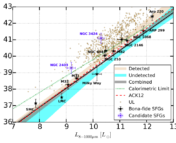Title: Very Large Telescope MUSE Observations of the Bubble Nebula around NGC 1313 X-2 and Evidence for Additional Photoionization
Authors: Changxing Zhou, Fuyan Bian, Hua Feng, and Jiahui Huang
First Author’s Institution: Department of Engineering Physics, Tsinghua University, Beijing, People’s Republic of China
Status: Published in ApJ [open access]
Ultraluminous X-ray Sources (ULXs) continue to be among the hot topics in X-ray astronomy, puzzling observers and theorists alike. These extragalactic X-ray sources emit unusually high X-ray luminosities, exceeding those produced by typical stellar black holes of ten times the solar masses (luminosities more than ~ 1039 erg/s). Although the nature of these objects remains unclear (are they intermediate mass black holes?), the current favored model suggests that ULXs are close binary systems with stellar-mass black holes (or neutron stars!).
Shock-ionized Bubble Nebulae around Ultraluminous X-ray Sources
To gain a more comprehensive understanding of ULXs beyond what can be obtained from the analysis of X-ray data, multiwavelength studies are necessary. In the optical wavelength, bubble-shaped diffuse emissions, known as bubble nebulae, have been found around many ULXs (see Figure 1). These nebulae have sizes ranging from several tens to hundreds of parsecs and expand at velocities of about 100 km/s. Most of them appear to be shock-ionized, powered by outflows (they could be strong winds or relativistic jets) colliding with the interstellar medium. By studying bubble nebulae, astronomers can constrain various properties of the ULX systems, such as the strength of the outflows, the characteristic ages, and the formation and mass-loss history. Such studies may also help bring an avenue to end the debate over the nature of these puzzling objects!

The Shocking Case of NGC 1313 X-2
The authors of today’s paper analyzed the NGC 1313 X-2 data, taken with the Multi-Unit Spectroscopic Explorer (MUSE), an integral field spectrograph (IFS) mounted on the Very Large Telescope (VLT). NGC 1313 X-2 was one of the first ULXs to be discovered and has been extensively studied. It has a bubble nebula that overlaps with the X-ray source position with an expansion velocity of 80 – 100 km/s. The high velocity of the expansion suggests that the emissions originate from radiative shocks, which is further supported by the presence of the [O I] and [S II] forbidden lines. Through their analysis of the MUSE data, the authors were able to gain new insights into the properties of this ULX system.
IFS instruments such as MUSE allow imaging and spectroscopy observations to be done at the same time, generating a final data product that contains spectral information at each spatial pixel (spaxel). Using MUSE data, the authors presented the first spatially resolved spectroscopic studies of the bubble nebula around NGC 1313 X-2. Each emission line on the nebula’s spectrum of each spaxel was modeled (or “fitted”) with a Gaussian distribution to derive the line properties, and to produce the flux, radial velocity, and velocity dispersion maps of the nebula (see Figure 2). They found that the doubly-ionized oxygen [O III] emission is enhanced at the region of the central X-ray source. To produce such a high-ionization emission line, either high velocity shocks or photoionization is required.

The authors then modeled the integrated H-alpha spectrum of the ULX region, assuming a shock velocity of 80 km/s from previous studies. They also take into account that the line kinematics observed are resulted from both approaching and receding motions of the nebula. Shockingly, a simple model with two Gaussian components failed to fit the line profile: this model’s line width is significantly larger than the observed line width. The same issue persisted even when the shock velocity was changed to any values between 50 – 100 km/s. When a third Gaussian component of low velocity was added, the model fit the observed line profile (see Figure 3). This low-velocity component in the spectrum could be evidence for additional photoionization happening in the bubble nebula.

To test whether photoionization could occur in addition to shocks ionization, the authors used MAPPINGS V, a plasma modeling code that handles both shocks and photoionization modeling. The simulations suggested that a pure shocks model could not explain the observed line ratios, and that photoionization needed to be added to reproduce the observations. This finding could indicate that the distance of the bubble nebula to its ionizing source may be closer than previously assumed, or that there are more ionizing sources, such as nearby O-type stars, contributing to the total luminosity of the ULX system. The authors also noted that this additional photoionization could affect the wind power calculation of the system, which is currently based on a shock-only model. This study proves that even though NGC 1313 X-2 is among the most extensively studied ULXs, there are still many shocking mysteries waiting to be explored!
Astrobite edited by Emma Clarke and Pratik Gandhi
Featured image credit: X-ray: NASA/CXC/Caltech/M. Brightman et al.; Optical: NASA/STScI





Awesome work!!
Indeed, the authors work is very interesting! You could also check out their group’s work on another ULXs here: https://arxiv.org/abs/2301.00022.
Great paper summary. Can’t wait to read another shocking findings about the interstellar world.
Thank you!